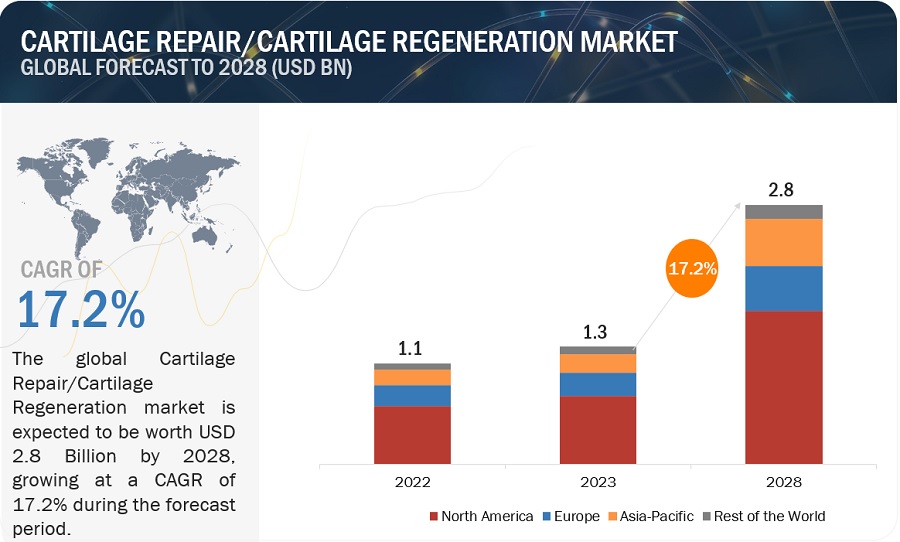The global cartilage repair market, valued at $1.3 billion in 2023, is projected to reach $2.8 billion by 2028, reflecting a robust compound annual growth rate (CAGR) of 17.2% from 2023 to 2028. This growth is driven by several factors, including the increasing prevalence of osteoarthritis, particularly in aging populations, and the expansion of healthcare infrastructure in emerging markets. The latest research provides a comprehensive analysis of industry trends, pricing strategies, patent landscapes, conference insights, key stakeholders, and buying behavior.

Key Drivers and Restraints
One of the primary drivers of the cartilage repair market is the rising incidence of osteoarthritis. According to WHO data from July 2023, approximately 528 million people globally were living with osteoarthritis in 2019—a 113% increase since 1990. With 73% of osteoarthritis patients being over 55 years old and 60% being female, the condition predominantly affects the knee, followed by the hip and hand. As a result, treatments such as autologous chondrocyte implantation and scaffold implants are increasingly in demand.
However, the high cost of cartilage repair surgeries presents a significant restraint. These procedures, while offering better and longer-lasting results compared to total knee replacements, can be prohibitively expensive, particularly in developing countries. For instance, knee replacement procedures typically cost around $16,000, whereas cartilage repair surgeries can range from $18,000 to $23,000.
Opportunities and Challenges
Technological advancements in cartilage repair present significant opportunities for market growth. However, the development and clinical use of cartilage-based stem cell products face challenges, including immune rejection, tumorigenesis, and ethical concerns. Regulatory bodies like the Human Tissue Authority (HTA) and the Medicines and Healthcare Products Regulatory Agency (MHRA) play a crucial role in monitoring these activities, particularly in the use of embryonic stem cells.
Market Ecosystem and Segment Insights
The cartilage repair market is dominated by established companies with diverse product portfolios and strong global sales networks. Key players include Smith+Nephew (UK), DePuy Synthes (Johnson & Johnson) (US), Zimmer Biomet Holdings, Inc. (US), Stryker Corporation (US), and Vericel Corporation (US).
In terms of application, the hyaline cartilage segment is expected to witness the highest growth due to increased contracts and agreements between key market players, along with rising investments in research and development. The knee segment, in particular, is anticipated to dominate the market, driven by the growing number of knee arthroscopy procedures, which are often used for cartilage reattachment.
Regional Dynamics
North America is expected to lead the cartilage repair market, particularly in the knee segment, due to the high prevalence of osteoarthritis and the advanced healthcare infrastructure in the region. The market’s expansion is supported by the continuous growth in the number of knee arthroscopy procedures.
Market Segmentation
The cartilage repair market is segmented into the following categories:
- By Region: North America, Europe, Asia Pacific, Rest of the World.
- By Treatment Modality: Cell-based (Chondrocyte Transplantation, Stem Cells, Growth Factors), Non-cell-based (Tissue Scaffolds, Cell-free Composites).
- By Application: Knee, Hip, Ankle and Foot, Other Application Sites.
- By Application Site: Hyaline Cartilage, Fibrocartilage.
With a promising growth trajectory and the continuous evolution of technologies, the cartilage repair market presents attractive opportunities for stakeholders and investors alike.
